Sophivorus (talk | contribs) (Undo revision 1096811 by StandardWikitext bot (talk)) Tag: Undo |
|||
| (47 intermediate revisions by 14 users not shown) | |||
| Line 1: | Line 1: | ||
[[ | [[File:09 vic bushfire damage Steels Creek 01 small.jpg|thumb|Steels Creek house damaged by bushfires in the Kinglake complex]] | ||
[[ | |||
[[ | {{Location data | ||
| location = Victoria, Australia | |||
| coordinates = 36° 35' 54.99" S, 144° 40' 40.82" E | |||
}} | |||
[[File:2009 Victorian bushfire Lake Mountain DSC 0335.jpg|thumb|Burnt toboggan run at Lake Mountain]] | |||
[[File:2009 Victorian bushfire Acheron Way DSC 0319.jpg|thumb|Forest regenerating along the Acheron Way]] | |||
The '''2009 Victorian bushfires''' on Saturday 7 February 2009 were the worst bushfires in Australia's history, surpassing both the Ash Wednesday fires in 1983 and the Black Friday fires in 1939. | The '''2009 Victorian bushfires''' on Saturday 7 February 2009 were the worst bushfires in Australia's history, surpassing both the Ash Wednesday fires in 1983 and the Black Friday fires in 1939. | ||
The bushfires travelled at alarming speed, up to 100km/h, across farmland and through plantations and heavily "managed" forests, including forests where recent fuel reduction burns had been done. | The bushfires travelled at alarming speed, up to 100km/h, across farmland and through plantations and heavily "managed" forests, including forests where recent fuel reduction burns had been done. | ||
Bushfire and climate scientists have confirmed that Victoria's hottest day | Bushfire and climate scientists have confirmed that Victoria's hottest day ever, combined with very strong north winds, created conditions for an unstoppable firestorm. | ||
==Kilmore East and Murrindindi Mill initial fire tracks== | == Kilmore East and Murrindindi Mill initial fire tracks == | ||
{{Map | |||
-37. | | data = | ||
-37. | -37.302460, 144.992752 ~ Start of Kimore fire (approx); | ||
-37.395801, 145.038757 | -37.354330, 145.025024 ~ Wandong; | ||
-37.487935, 145.180893 | -37.395801, 145.038757; | ||
-37.536955, 145.284576 | -37.487935, 145.180893 ~ Humevale; | ||
-37.587575, 145.364914 | -37.536955, 145.284576; | ||
-37.591927, 145.370407 | -37.587575, 145.364914; | ||
-37.550021, 145. | -37.591927, 145.370407 ~ Steels Creek; | ||
-37.468319, 145.272903 | -37.550021, 145.386200; | ||
-37.400165, 145.156174 | -37.468319, 145.272903; | ||
-37.333586, 145.075836 | -37.400165, 145.156174; | ||
-37.301914, 144.994125 | -37.333586, 145.075836; | ||
-37.369066, 145.008545 | -37.301914, 144.994125; | ||
-37.345051, 144.992065 | -37.369066, 145.008545; | ||
-37.331949, 144.998932 | -37.345051, 144.992065; | ||
-37.331949, 144.998932; | |||
-37.526337, 145.256424 | -37.526337, 145.256424 ~ Kilmore ~ East fire front to St Andrews; | ||
-37.601176, 145. | -37.601176, 145.265350; | ||
-37. | -37.651480, 145.310669; | ||
-37.650937, 145.344658 | -37.650937, 145.344658; | ||
-37.381070, 145.540867 ~ Murrundindi ~ Mill fire start (approx); | |||
-37. | -37.417754, 145.564213; | ||
-37.417754, 145.564213 | -37.564174, 145.654678 ~ Narbethong ~ (destroyed); | ||
-37.564174, 145.654678 | -37.510815, 145.735016 ~ Marysville ~ (destroyed); | ||
-37.510815, 145.735016 | -37.504279, 145.756989; | ||
-37.504279, 145.756989 | -37.418163, 145.656738; | ||
-37.418163, 145.656738 | -37.387072, 145.583954; | ||
-37.387072, 145.583954 | -37.381070, 145.544815; | ||
-37. | | cluster = no | ||
}} | |||
Initial track of the fires that started at Kilmore East and Murrindindi Mill. | Initial track of the fires that started at Kilmore East and Murrindindi Mill. | ||
| Line 47: | Line 54: | ||
Note: this map is not accurate | Note: this map is not accurate | ||
Note that the fire fronts changed direction to travel North East after the southerly wind change. | Note that the fire fronts changed direction to travel North East after the southerly wind change. This wind change created a huge fire front along the entire edges of the previous fire track, and resulted in Flowerdale being burnt. | ||
The bushfires slowed considerably when they eventually entered Melbourne's water catchments, but they continued to burn. Intact wet sclerophyll forests in our water catchments are less prone to burning, and temperatures and wind speeds have eased. | The bushfires slowed considerably when they eventually entered Melbourne's water catchments, but they continued to burn. Intact wet sclerophyll forests in our water catchments are less prone to burning, and temperatures and wind speeds have eased. | ||
==Chronology of the fires== | == Chronology of the fires == | ||
[[ | [[File:Marysville bushfire aerial.jpg|thumb|Marysville after the bushfire]] | ||
;Wednesday 28 January 2009 | ;Wednesday 28 January 2009 | ||
| Line 65: | Line 72: | ||
:Kilmore fire started on farmland at about 14:30 | :Kilmore fire started on farmland at about 14:30 | ||
:Wandong, Kinglake West, Strathewan, Kinglake and Steels Creek and Flowerdale townships burnt. | :Wandong, Kinglake West, Strathewan, Kinglake and Steels Creek and Flowerdale townships burnt. | ||
:Murrindindi Mill fire started, arson suspected. | :Murrindindi Mill fire started, arson suspected. | ||
:Narbethong and Marysville townships burnt. | :Narbethong and Marysville townships burnt. | ||
:Churchill fire started, arson suspected. | :Churchill fire started, arson suspected. | ||
| Line 76: | Line 83: | ||
:Wilsons Promontory fire started by lightning | :Wilsons Promontory fire started by lightning | ||
==Weather== | == Weather == | ||
The fires came as Melbourne reached its hottest ever temperature of 46.4 degrees.<ref>[http://www.theage.com.au/national/death-toll-may-reach-more-than-40-police-20090207-80ao.html?page=-1 Death toll may reach more than 40: police], The Age, February 7, 2009</ref> | The fires came as Melbourne reached its hottest ever temperature of 46.4 degrees.<ref>[http://www.theage.com.au/national/death-toll-may-reach-more-than-40-police-20090207-80ao.html?page=-1 Death toll may reach more than 40: police], The Age, February 7, 2009</ref> | ||
The extremely hot temperatures were accompanied by very strong north westerly winds, which changed to strong south easterly winds in the late afternoon. | The extremely hot temperatures were accompanied by very strong north westerly winds, which changed to strong south easterly winds in the late afternoon. | ||
The combination of extreme heat and very strong winds resulted in the highest ever '''fire danger index warnings''' recorded in Australia.<ref>[http://www.theaustralian.news.com.au/story/0,25197,25080722-5018722,00.html Extreme fire risks off the scale], The Australian</ref> | The combination of extreme heat and very strong winds resulted in the highest ever '''fire danger index warnings''' recorded in Australia.<ref>[http://web.archive.org/web/20090221020728/http://www.theaustralian.news.com.au:80/story/0,25197,25080722-5018722,00.html Extreme fire risks off the scale], The Australian</ref> | ||
The fire danger index scale ranges from 0 to 100, with 100 being extreme fire danger. | The fire danger index scale ranges from 0 to 100, with 100 being extreme fire danger. During Saturday 7 February, index warnings above 150 across Victoria were advised, with some areas exceeding 200. | ||
[[ | [[File:2009-02-07 Fawkner Beacon wind chart.jpg|400px]] | ||
Wind chart from Fawkner Beacon in Port Phillip bay illustrating wind change to Southerly at approximately 5pm in Melbourne | Wind chart from Fawkner Beacon in Port Phillip bay illustrating wind change to Southerly at approximately 5pm in Melbourne | ||
==Links between extreme bushfires and climate change== | == Links between extreme bushfires and climate change == | ||
Professor | |||
Professor David Karoly has stated that the extreme weather parameters on and leading up to February 7 were the most important factor, including: | |||
* Record low rainfall - 35 days of no rain up to February 7 | * Record low rainfall - 35 days of no rain up to February 7 | ||
* Record low relatively humidity on February 7th of 5% | * Record low relatively humidity on February 7th of 5% | ||
| Line 98: | Line 108: | ||
Bushfire index ratings compared between extreme fires are: | Bushfire index ratings compared between extreme fires are: | ||
* 100: Black Friday in 1939 | * 100: Black Friday in 1939 | ||
* 120: Ash Wednesday in 1983 | * 120: Ash Wednesday in 1983 | ||
| Line 109: | Line 120: | ||
* It is difficult to separate the influences of climate variability, climate change, and changes in fire management strategies on observed increases in fire activity | * It is difficult to separate the influences of climate variability, climate change, and changes in fire management strategies on observed increases in fire activity | ||
* Climate change is increasing the likelihood of environmental conditions associated with extreme fire danger in south-east Australia | * Climate change is increasing the likelihood of environmental conditions associated with extreme fire danger in south-east Australia | ||
* Observed increases in forest fire activity have been linked to climate change in the western US, in Canada, in Spain and in Greece.<ref name="2009Melbourneseminar">[http://petercampbell.blogspot.com/2009/04/extreme-weather-was-main-cause-of-black.html | * Observed increases in forest fire activity have been linked to climate change in the western US, in Canada, in Spain and in Greece.<ref name="2009Melbourneseminar">[http://petercampbell.blogspot.com/2009/04/extreme-weather-was-main-cause-of-black.html Extreme weather was the main cause of the Black Saturday bushfires], Melbourne University seminar, 21 April 2009</ref><ref>[http://www.realclimate.org/index.php/archives/2009/02/bushfires-and-climate/ Bushfires and extreme heat in south-east Australia], Professor David Karoly, Realclimate.org</ref> | ||
== Impacts of fires == | |||
[[File:Y194967614280291.jpg|thumb]] | |||
=== Loss of property === | |||
* The fires have destroyed at least 1,834 homes, with thousands more suffering damage. | * The fires have destroyed at least 1,834 homes, with thousands more suffering damage. | ||
* The fires have left an estimated 7,500 people homeless. | * The fires have left an estimated 7,500 people homeless. | ||
===Deaths=== | === Deaths === | ||
* As at May 13 , 2009, 173 people are reported dead. | |||
* As at May 13, 2009, 173 people are reported dead. | |||
* Several million native animals are estimated to have died. | * Several million native animals are estimated to have died. | ||
===Carbon emissions=== | === Carbon emissions === | ||
===Water harvest falls=== | Millions of tonnes of carbon have been released to the atmosphere. Australia's total emissions per year are around 330m tonnes of CO2. Previous research has shown that the bush fires in 2003 and 2006-07 had put up to 105m tonnes of carbon dioxide into the atmosphere because they burned up land carrying 50 to 80 tonnes of carbon per hectare. This time, however, the forests being destroyed are even more carbon-rich, with more than 100 tonnes of above-ground carbon per hectare. The affected area is more than twice the size of London and takes in more than 20 towns north of Melbourne, so the CO2 emissions from this year's disaster could be far larger than previous fires.<ref>[http://www.guardian.co.uk/environment/2009/feb/13/carbonemissions-australia Australian bushfires pump out millions of tonnes of carbon], guardian.co.uk</ref> | ||
Water collection in dams affected by Victoria's bushfires could fall by 30 per cent in the decades ahead, Melbourne Water officials have warned. | |||
<ref>[http://www.theage.com.au/national/water-harvest-from-dams-may-fall-30-20090217-8aa4.html Water harvest from dams may fall 30%], The Age, February 18, 2009</ref> | === Water harvest falls === | ||
Water collection in dams affected by Victoria's bushfires could fall by 30 per cent in the decades ahead, Melbourne Water officials have warned. Three of Melbourne's four most important reservoirs have had fires in their catchments during the past 10 days, with two of the catchments suffering significant damage.<ref>[http://www.theage.com.au/national/water-harvest-from-dams-may-fall-30-20090217-8aa4.html Water harvest from dams may fall 30%], The Age, February 18, 2009</ref> | |||
=== Power and phone network failures === | |||
The following power lines which supply Melbourne with electricity failed during the bushfires: | The following power lines which supply Melbourne with electricity failed during the bushfires: | ||
* Two power lines in the Latrobe valley, due to the Churchill fire | * Two power lines in the Latrobe valley, due to the Churchill fire | ||
* One power line to the north of Melbourne, due to the Kilmore fire | * One power line to the north of Melbourne, due to the Kilmore fire | ||
An electricity spokesperson stated on the Radio 774 on February 7 that Melbourne was very close to losing its power as a result of these fires. | An electricity spokesperson stated on the Radio 774 on February 7 that Melbourne was very close to losing its power as a result of these fires. If another power line had been impacted the entire grid would have been temporarily shut down. | ||
Phone networks failed in fire areas when the following infrastructure was destroyed by fire: | Phone networks failed in fire areas when the following infrastructure was destroyed by fire: | ||
* poles and wires for landline phone networks. | * poles and wires for landline phone networks. | ||
* transmitter towers for mobile networks. | * transmitter towers for mobile networks. | ||
==Measures to reduce impacts of bushfires== | == Measures to reduce impacts of bushfires == | ||
After the fires, there has been much speculation about measures that could be adopted to reduce bushfire risks and impacts. | |||
After the fires, there has been much speculation about measures that could be adopted to reduce bushfire risks and impacts. A Royal Commission with a wide terms of reference has been announced by the Victorian Government to investigate these bushfires and make recommendations. | |||
Some possible measures that may reduce bushfire risks and impacts include: | Some possible measures that may reduce bushfire risks and impacts include: | ||
| Line 149: | Line 170: | ||
* An early warning notification system via landline and mobile phones | * An early warning notification system via landline and mobile phones | ||
===Possible new building regulations=== | === Possible new building regulations === | ||
New building regulations to improve the fire resistant qualities of building such as: | New building regulations to improve the fire resistant qualities of building such as: | ||
===Steels Creek house - built to survive a bushfire=== | * Minimise or eliminate external woodwork such as deckings | ||
[[ | * Gutters which do not trap burning embers and leaves | ||
* Sealed roofs which do not allow burning leaves and embers in | |||
* Use of earth berms to protect building walls | |||
* Double glazed windows to provide more robust windows | |||
* Fire proof shutters over windows | |||
* Sprinkler systems to wet building roof spaces and walls | |||
* Gutter and downpipe systems that can be blocked and filled with water | |||
* Fire resistant wall materials such as concrete or tin | |||
* Provision of battery or petrol/diesel powered pumps and fire proof hoses for extinguishing and fighting fire | |||
* Concrete water tanks (plastic tanks were melted by the bushfires) | |||
=== Steels Creek house - built to survive a bushfire === | |||
[[File:Steels Creek house.jpg|thumb|Steels Creek house]] | |||
Despite being attacked twice by fire on Black Saturday from two different directions Mr Williams' Steels Creek home stood solid while everything around it was destroyed. Four of his neighbours died. | Despite being attacked twice by fire on Black Saturday from two different directions Mr Williams' Steels Creek home stood solid while everything around it was destroyed. Four of his neighbours died. | ||
| Line 174: | Line 198: | ||
* Double-glazed doors and windows, some outside panes cracked in the heat | * Double-glazed doors and windows, some outside panes cracked in the heat | ||
* Autoclaved aerated concrete bricks (AAC) and concrete slab construction | * Autoclaved aerated concrete bricks (AAC) and concrete slab construction | ||
* No external timber to catch fire. | * No external timber to catch fire. | ||
* Door frames are steel and so is part of the balcony. | * Door frames are steel and so is part of the balcony. | ||
* Colorbond tin roof | * Colorbond tin roof | ||
| Line 180: | Line 204: | ||
* A sprinkler system operates on three levels. In total, there are 30 sprinkler heads around the house, using 200 litres a minute, can create a water canopy around the house<ref>[http://www.theage.com.au/national/meet-guy-who-found-shelter-from-the-fires-20090220-8dqt.html?page=-1 Meet Guy, who found shelter from the fires], The Age</ref> | * A sprinkler system operates on three levels. In total, there are 30 sprinkler heads around the house, using 200 litres a minute, can create a water canopy around the house<ref>[http://www.theage.com.au/national/meet-guy-who-found-shelter-from-the-fires-20090220-8dqt.html?page=-1 Meet Guy, who found shelter from the fires], The Age</ref> | ||
===Fuel reduction burning controversy=== | === Fuel reduction burning controversy === | ||
After the bushfires, some commentators have claimed that increased fuel loads and a lack of fuel reduction burning in forests contributed to the severity of the fires. | After the bushfires, some commentators have claimed that increased fuel loads and a lack of fuel reduction burning in forests contributed to the severity of the fires. However, the fires burnt through plantations, farmland and forest areas, including regions where extensive fuel reduction burning had been done. For example: | ||
* extensive fuel reduction burning has been conducted around Marysville over the last decade and a firebreak was constructed around the town.<ref> | |||
* extensive fuel reduction burning has been conducted around Marysville over the last decade and a firebreak was constructed around the town.<ref>We need to talk about the forests, The Canberra Times, Feb 23, 2009</ref> | |||
* Two thirds of the Bunyip fire was on cleared farmland | * Two thirds of the Bunyip fire was on cleared farmland | ||
* The Kilmore fire started on and traversed large areas of farmland before it entered forested areas. | * The Kilmore fire started on and traversed large areas of farmland before it entered forested areas. | ||
| Line 196: | Line 221: | ||
* Fire behaviour is a dynamic process and therefore needs dynamic modelling. | * Fire behaviour is a dynamic process and therefore needs dynamic modelling. | ||
Kevin stated that the extreme weather dominated the fire behaviour rather than fuel loads which played a lesser role. As an example, he mentioned the Lara bushfire on grass paddocks on 8 January 1969 along the Geelong Road that killed 17 people trapped in their cars. In total, 280 fires broke out on the 8th of January 1969. Of these, 12 grass fires reached major proportions and burnt 250,000 hectares. The fires also destroyed 230 houses, 21 other buildings and more than 12,000 stock.<ref name="2009Melbourneseminar"/> | Kevin stated that the extreme weather dominated the fire behaviour rather than fuel loads which played a lesser role. As an example, he mentioned the Lara bushfire on grass paddocks on 8 January 1969 along the Geelong Road that killed 17 people trapped in their cars. In total, 280 fires broke out on the 8th of January 1969. Of these, 12 grass fires reached major proportions and burnt 250,000 hectares. The fires also destroyed 230 houses, 21 other buildings and more than 12,000 stock.<ref name="2009Melbourneseminar" /> | ||
=== Communications technology === | |||
The scale and speed of the bushfires placed extremely high demands on emergency communications, including: | The scale and speed of the bushfires placed extremely high demands on emergency communications, including: | ||
* the emergency 000 telephone service overloaded with call, some of which were dropped | * the emergency 000 telephone service overloaded with call, some of which were dropped | ||
* radio traffic to and from CFA vehicles was very congested. Many trucks were unable to provide regular situation reports. | * radio traffic to and from CFA vehicles was very congested. Many trucks were unable to provide regular situation reports. | ||
| Line 206: | Line 233: | ||
* overloading of mobile phone networks due to high call volumes and congestion. | * overloading of mobile phone networks due to high call volumes and congestion. | ||
Distributed and asynchronous communications technologies could be more effective for handling the large volume of messages and information that needs to be shared in these type of emergencies. | Distributed and asynchronous communications technologies could be more effective for handling the large volume of messages and information that needs to be shared in these type of emergencies. Options include: | ||
* Twitter and/or Facebook status updates - via mobile phone or email (or a specfic emergency services platform using similar technologies) | * Twitter and/or Facebook status updates - via mobile phone or email (or a specfic emergency services platform using similar technologies) | ||
* Wikis, blogs and content management systems for rapidly updating website information | * Wikis, blogs and content management systems for rapidly updating website information | ||
| Line 212: | Line 240: | ||
The Royal Commission will investigate these matters further. | The Royal Commission will investigate these matters further. | ||
===Rebuilding with prefabricated "pods"=== | === Rebuilding with prefabricated "pods" === | ||
[[File:Regrowth Pod 1.jpg|thumb|House re-Growth Pod]] | |||
==Royal Commission== | [[File:Regrowth Pod 2.jpg|thumb|House re-Growth Pod]] | ||
The [[House re-Growth Pod]] has been designed by architect who wanted to help with the re-building process of fire destroyed homes in Victoria. The dwelling is a completely self contained concrete service pod which is s a permanent and cost effective housing unit which can assist in the rebuilding of the fire devastated town-ships of Victoria. | |||
The robust pre-fabricated concrete structure has been designed to be built upon, but in the short term acts as a habitable starting point for the building of a new home. The units can be prefabricated, delivered and connected to services rapidly allowing families to begin the process of re-building without displacement from their communities<ref>House re-Growth Pod</ref><ref>[http://www.news.com.au/heraldsun/story/0,21985,25314898-661,00.html Small concrete boxes to house bushfire victims], Herald Sun</ref> | |||
== Royal Commission == | |||
The Royal Commission's terms of reference were released on Monday 16 February 2009 and include inquiring into and reporting on the following matters: | The Royal Commission's terms of reference were released on Monday 16 February 2009 and include inquiring into and reporting on the following matters: | ||
# The causes and circumstances of the bushfires. | # The causes and circumstances of the bushfires. | ||
# The preparation and planning by governments, emergency services, other entities, the community and households for bushfires in Victoria, including current laws, policies, practices, resources and strategies for the prevention, identification, evaluation, management and communication of bushfire threats and risks. | # The preparation and planning by governments, emergency services, other entities, the community and households for bushfires in Victoria, including current laws, policies, practices, resources and strategies for the prevention, identification, evaluation, management and communication of bushfire threats and risks. | ||
| Line 229: | Line 261: | ||
Recommendations arising out the inquiry are indicated on: | Recommendations arising out the inquiry are indicated on: | ||
* The preparation and planning for future bushfire threats and risks, particularly the prevention of loss of life. | * The preparation and planning for future bushfire threats and risks, particularly the prevention of loss of life. | ||
* Land use planning and management, including urban and regional planning | * Land use planning and management, including urban and regional planning | ||
| Line 236: | Line 269: | ||
* Training, infrastructure, and overall resourcing needs. | * Training, infrastructure, and overall resourcing needs. | ||
==Causes of death== | == Causes of death == | ||
* Radiant heat; trapped in dwelling for shelter or while defending against fire | * Radiant heat; trapped in dwelling for shelter or while defending against fire | ||
* Radiant heat; trapped in motor vehicle while attempting to evacuate | * Radiant heat; trapped in motor vehicle while attempting to evacuate | ||
* Motor vehicle accident while attempting to evacuate (not confirmed) | * Motor vehicle accident while attempting to evacuate (not confirmed) | ||
==Photographs== | == Photographs == | ||
===Acheron Way, 10 April 2009=== | === Acheron Way, 10 April 2009 === | ||
< | |||
<gallery> | |||
Image:2009 Victorian bushfire Acheron Way DSC 0324.jpg | Image:2009 Victorian bushfire Acheron Way DSC 0324.jpg | ||
Image:2009 Victorian bushfire Acheron Way DSC 0316.jpg | Image:2009 Victorian bushfire Acheron Way DSC 0316.jpg | ||
Image:2009 Victorian bushfire Acheron Way DSC 0319.jpg | Image:2009 Victorian bushfire Acheron Way DSC 0319.jpg | ||
Image:2009 Victorian bushfire Acheron Way DSC 0315.jpg | Image:2009 Victorian bushfire Acheron Way DSC 0315.jpg | ||
Image:2009 Victorian bushfire Acheron Way DSC 0326.jpg | Image:2009 Victorian bushfire Acheron Way DSC 0326.jpg | ||
Image:2009 Victorian bushfire Acheron Way DSC 0329.jpg | Image:2009 Victorian bushfire Acheron Way DSC 0329.jpg | ||
Image:2009 Victorian bushfire Acheron Way DSC 0331.jpg | Image:2009 Victorian bushfire Acheron Way DSC 0331.jpg | ||
Image:2009 Victorian bushfire Acheron Way DSC 0332.jpg | Image:2009 Victorian bushfire Acheron Way DSC 0332.jpg | ||
</ | </gallery> | ||
===Lake Mountain, 10 April 2009=== | === Lake Mountain, 10 April 2009 === | ||
==See also== | <gallery> | ||
* | File:2009 Victorian bushfire Lake Mountain DSC 0335.jpg | ||
* | File:2009 Victorian bushfire Lake Mountain DSC 0337.jpg | ||
File:2009 Victorian bushfire Lake Mountain DSC 0339.jpg | |||
File:2009 Victorian bushfire Lake Mountain DSC 0344.jpg | |||
File:2009 Victorian bushfire Lake Mountain DSC 0351.jpg | |||
</gallery> | |||
== See also == | |||
* Recent news articles on the 2009 Victorian bushfires | |||
* 2009 Victorian bushfires Royal Commission submission | |||
* Quotes on 2009 Victorian bushfires | |||
== References == | |||
<References/> | <References/> | ||
==External links== | == External links == | ||
* [[Wikipedia:2009 Victorian bushfires]] | * [[Wikipedia:2009 Victorian bushfires]] | ||
* [http://www.myenvironment.net.au/index.php/me/resources/bush_fire Bush Fire], myenvironment.net.au, scientific and evidenced based information about bushfires and the environment with links to media, science, research and opinion articles. | * [http://web.archive.org/web/20091216144244/http://www.myenvironment.net.au:80/index.php/me/resources/bush_fire Bush Fire], myenvironment.net.au, scientific and evidenced based information about bushfires and the environment with links to media, science, research and opinion articles. | ||
* [http://www.redcross.org.au/vic/services_emergencyservices_victorian-bushfires-appeal-2009.htm Red Cross bushfile appeal (donations accepted)] | * [http://web.archive.org/web/20170818073320/http://www.redcross.org.au/vic/services_emergencyservices_victorian-bushfires-appeal-2009.htm Red Cross bushfile appeal (donations accepted)] | ||
* [http://candobetter.org/VictorianFires2009 Victorian fires 2009], (We) can do better | * [http://candobetter.org/VictorianFires2009 Victorian fires 2009], (We) can do better | ||
* [http://www.guardian.co.uk/commentisfree/2009/feb/13/australia-bushfires-green#history-byline Australia's bushfires: the blame game], Guy Rundle, guardian.co.uk | * [http://www.guardian.co.uk/commentisfree/2009/feb/13/australia-bushfires-green#history-byline Australia's bushfires: the blame game], Guy Rundle, guardian.co.uk | ||
* [http://www.theage.com.au/national/lessons-from-the-ashes-20090215-8810.html Lessons from the ashes], The Age | * [http://www.theage.com.au/national/lessons-from-the-ashes-20090215-8810.html Lessons from the ashes], The Age | ||
* [http://www.google.com.au/landing/victorianbushfires/ Interactive map of Victorian bushfires], Google.com.au | * [http://web.archive.org/web/20110406130004/http://www.google.com.au/landing/victorianbushfires/ Interactive map of Victorian bushfires], Google.com.au | ||
* [http://www.premier.vic.gov.au/premier/fires-royal-commission-to-have-wide-terms-of-reference.html Fires royal commission to have wide terms of reference], Premier of Victoria, Australia | * [http://web.archive.org/web/20090709150916/http://www.premier.vic.gov.au/premier/fires-royal-commission-to-have-wide-terms-of-reference.html Fires royal commission to have wide terms of reference], Premier of Victoria, Australia | ||
* [http://www.realclimate.org/index.php/archives/2009/02/bushfires-and-climate/#more-654 Bushfires and extreme heat in south-east Australia], RealClimate, 16 February 2009 | * [http://www.realclimate.org/index.php/archives/2009/02/bushfires-and-climate/#more-654 Bushfires and extreme heat in south-east Australia], RealClimate, 16 February 2009 | ||
{{Page data | |||
| keywords = Climate change, Bushfire, Natural disasters | |||
| sdg = SDG13 Climate action, SDG15 Life on land | |||
| organizations = Green living wiki | |||
| ported-from = http://www.greenlivingpedia.org/2009_Victorian_bushfires | |||
}} | |||
[[Category:Climate change]] | [[Category:Climate change]] | ||
[[Category: | [[Category:Natural disasters]] | ||
Latest revision as of 14:40, 21 March 2024
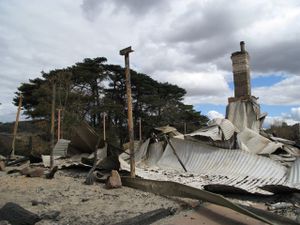
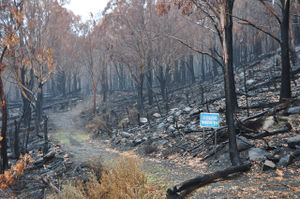
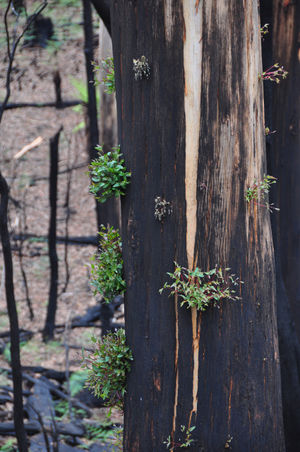
The 2009 Victorian bushfires on Saturday 7 February 2009 were the worst bushfires in Australia's history, surpassing both the Ash Wednesday fires in 1983 and the Black Friday fires in 1939.
The bushfires travelled at alarming speed, up to 100km/h, across farmland and through plantations and heavily "managed" forests, including forests where recent fuel reduction burns had been done.
Bushfire and climate scientists have confirmed that Victoria's hottest day ever, combined with very strong north winds, created conditions for an unstoppable firestorm.
Kilmore East and Murrindindi Mill initial fire tracks[edit | edit source]
Initial track of the fires that started at Kilmore East and Murrindindi Mill.
Note: this map is not accurate
Note that the fire fronts changed direction to travel North East after the southerly wind change. This wind change created a huge fire front along the entire edges of the previous fire track, and resulted in Flowerdale being burnt.
The bushfires slowed considerably when they eventually entered Melbourne's water catchments, but they continued to burn. Intact wet sclerophyll forests in our water catchments are less prone to burning, and temperatures and wind speeds have eased.
Chronology of the fires[edit | edit source]
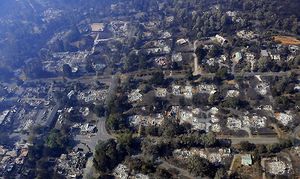
- Wednesday 28 January 2009
- Delburn fire started in Gippsland, arson suspected.
- Monday 2 February 2009.
- Bunyip State Park fire started by lightning
- Saturday 7 February 2009. Black Saturday
- Horsham fire started at 12:30
- Kilmore fire started on farmland at about 14:30
- Wandong, Kinglake West, Strathewan, Kinglake and Steels Creek and Flowerdale townships burnt.
- Murrindindi Mill fire started, arson suspected.
- Narbethong and Marysville townships burnt.
- Churchill fire started, arson suspected.
- Bendigo fire started at 16:30
- 17:00 Wind direction changed from northerly to southerly in Melbourne
- Beechworth fire started at 19:00
- Sunday 8 February 2009.
- Kilmore and Murrindindi Mill fires merge to form the Kinglake fire complex.
- Wilsons Promontory fire started by lightning
Weather[edit | edit source]
The fires came as Melbourne reached its hottest ever temperature of 46.4 degrees.[1]
The extremely hot temperatures were accompanied by very strong north westerly winds, which changed to strong south easterly winds in the late afternoon.
The combination of extreme heat and very strong winds resulted in the highest ever fire danger index warnings recorded in Australia.[2]
The fire danger index scale ranges from 0 to 100, with 100 being extreme fire danger. During Saturday 7 February, index warnings above 150 across Victoria were advised, with some areas exceeding 200.
Wind chart from Fawkner Beacon in Port Phillip bay illustrating wind change to Southerly at approximately 5pm in Melbourne
Links between extreme bushfires and climate change[edit | edit source]
Professor David Karoly has stated that the extreme weather parameters on and leading up to February 7 were the most important factor, including:
- Record low rainfall - 35 days of no rain up to February 7
- Record low relatively humidity on February 7th of 5%
- The hottest recorded temperature of 46.7 on February 7
The strong north winds and the southerly wind change on February 7th were not unusual in themselves, but combined with the above factors, and ignition of the fires, the results were catastrophic.
Bushfire index ratings compared between extreme fires are:
- 100: Black Friday in 1939
- 120: Ash Wednesday in 1983
- 140 to 190: Black Saturday. These figures have never been seen before and are regarded as in the "catastrophic" range.
Professor Karoly also pointed out that CSIRO scientific predictions are that the current rate of climate change were are experiencing will result in 4 times as many extreme fire dangers days like Black Saturday each year by 2050.
He concluded with these observations:
- A tragedy occurred with the bushfires in SE Australia on 7 February 2009
- It is difficult to separate the influences of climate variability, climate change, and changes in fire management strategies on observed increases in fire activity
- Climate change is increasing the likelihood of environmental conditions associated with extreme fire danger in south-east Australia
- Observed increases in forest fire activity have been linked to climate change in the western US, in Canada, in Spain and in Greece.[3][4]
Impacts of fires[edit | edit source]
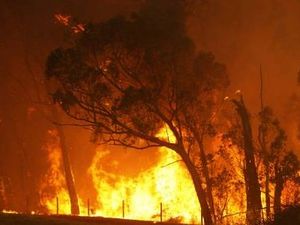
Loss of property[edit | edit source]
- The fires have destroyed at least 1,834 homes, with thousands more suffering damage.
- The fires have left an estimated 7,500 people homeless.
Deaths[edit | edit source]
- As at May 13, 2009, 173 people are reported dead.
- Several million native animals are estimated to have died.
Carbon emissions[edit | edit source]
Millions of tonnes of carbon have been released to the atmosphere. Australia's total emissions per year are around 330m tonnes of CO2. Previous research has shown that the bush fires in 2003 and 2006-07 had put up to 105m tonnes of carbon dioxide into the atmosphere because they burned up land carrying 50 to 80 tonnes of carbon per hectare. This time, however, the forests being destroyed are even more carbon-rich, with more than 100 tonnes of above-ground carbon per hectare. The affected area is more than twice the size of London and takes in more than 20 towns north of Melbourne, so the CO2 emissions from this year's disaster could be far larger than previous fires.[5]
Water harvest falls[edit | edit source]
Water collection in dams affected by Victoria's bushfires could fall by 30 per cent in the decades ahead, Melbourne Water officials have warned. Three of Melbourne's four most important reservoirs have had fires in their catchments during the past 10 days, with two of the catchments suffering significant damage.[6]
Power and phone network failures[edit | edit source]
The following power lines which supply Melbourne with electricity failed during the bushfires:
- Two power lines in the Latrobe valley, due to the Churchill fire
- One power line to the north of Melbourne, due to the Kilmore fire
An electricity spokesperson stated on the Radio 774 on February 7 that Melbourne was very close to losing its power as a result of these fires. If another power line had been impacted the entire grid would have been temporarily shut down.
Phone networks failed in fire areas when the following infrastructure was destroyed by fire:
- poles and wires for landline phone networks.
- transmitter towers for mobile networks.
Measures to reduce impacts of bushfires[edit | edit source]
After the fires, there has been much speculation about measures that could be adopted to reduce bushfire risks and impacts. A Royal Commission with a wide terms of reference has been announced by the Victorian Government to investigate these bushfires and make recommendations.
Some possible measures that may reduce bushfire risks and impacts include:
- Fire-proof bunkers under or near houses. However, bunkers are not classified as structural items under the building code, so improved regulations for them are required.
- Larger community fire-proof buildings in towns and schools.
- Fire-retardant plants near buildings.
- Clearing vegetation for the close proximity of buildings.
- An early warning notification system via landline and mobile phones
Possible new building regulations[edit | edit source]
New building regulations to improve the fire resistant qualities of building such as:
- Minimise or eliminate external woodwork such as deckings
- Gutters which do not trap burning embers and leaves
- Sealed roofs which do not allow burning leaves and embers in
- Use of earth berms to protect building walls
- Double glazed windows to provide more robust windows
- Fire proof shutters over windows
- Sprinkler systems to wet building roof spaces and walls
- Gutter and downpipe systems that can be blocked and filled with water
- Fire resistant wall materials such as concrete or tin
- Provision of battery or petrol/diesel powered pumps and fire proof hoses for extinguishing and fighting fire
- Concrete water tanks (plastic tanks were melted by the bushfires)
Steels Creek house - built to survive a bushfire[edit | edit source]
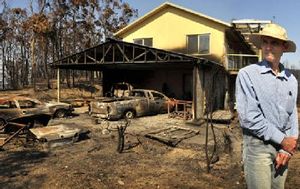
Despite being attacked twice by fire on Black Saturday from two different directions Mr Williams' Steels Creek home stood solid while everything around it was destroyed. Four of his neighbours died.
The fire that bore down on his house was about 1200 degrees, hot enough to soften the metal but not melt it. Glass doors and windows in his house are all double-glazed. Some of the outside panes cracked in the heat. Next time he'll add shutters
Features of the Steels Creek house that assisted its survival:
- Double-glazed doors and windows, some outside panes cracked in the heat
- Autoclaved aerated concrete bricks (AAC) and concrete slab construction
- No external timber to catch fire.
- Door frames are steel and so is part of the balcony.
- Colorbond tin roof
- Solar panel array (now badly damaged)
- A sprinkler system operates on three levels. In total, there are 30 sprinkler heads around the house, using 200 litres a minute, can create a water canopy around the house[7]
Fuel reduction burning controversy[edit | edit source]
After the bushfires, some commentators have claimed that increased fuel loads and a lack of fuel reduction burning in forests contributed to the severity of the fires. However, the fires burnt through plantations, farmland and forest areas, including regions where extensive fuel reduction burning had been done. For example:
- extensive fuel reduction burning has been conducted around Marysville over the last decade and a firebreak was constructed around the town.[8]
- Two thirds of the Bunyip fire was on cleared farmland
- The Kilmore fire started on and traversed large areas of farmland before it entered forested areas.
- A relatively small grass fire in Narre Warren burnt several houses before it was contained.
Fire scientist Dr Kevin Tolhurst stated at a seminar on 21 April 2009 that:
- Dominant factors affecting fire behaviour change with the scale of the fire
- Fire size and atmospheric instabilty are important to blowup fire behaviour - they enable feedback which increases the fire intensity
- Drought is an important precursor to high intensity fires - previously "wet" forests, gullies and moist slopes burn
- The fire footprint (the overall size of the area burnt) is determined by only a few hours of extreme weather
- Fire behaviour is a dynamic process and therefore needs dynamic modelling.
Kevin stated that the extreme weather dominated the fire behaviour rather than fuel loads which played a lesser role. As an example, he mentioned the Lara bushfire on grass paddocks on 8 January 1969 along the Geelong Road that killed 17 people trapped in their cars. In total, 280 fires broke out on the 8th of January 1969. Of these, 12 grass fires reached major proportions and burnt 250,000 hectares. The fires also destroyed 230 houses, 21 other buildings and more than 12,000 stock.[3]
Communications technology[edit | edit source]
The scale and speed of the bushfires placed extremely high demands on emergency communications, including:
- the emergency 000 telephone service overloaded with call, some of which were dropped
- radio traffic to and from CFA vehicles was very congested. Many trucks were unable to provide regular situation reports.
- single "hub" radio operators had to deal with many mobile units.
- mobile and land line phone network infrastructure were both badly damaged by the fires, and in many places were inoperable
- overloading of mobile phone networks due to high call volumes and congestion.
Distributed and asynchronous communications technologies could be more effective for handling the large volume of messages and information that needs to be shared in these type of emergencies. Options include:
- Twitter and/or Facebook status updates - via mobile phone or email (or a specfic emergency services platform using similar technologies)
- Wikis, blogs and content management systems for rapidly updating website information
The Royal Commission will investigate these matters further.
Rebuilding with prefabricated "pods"[edit | edit source]
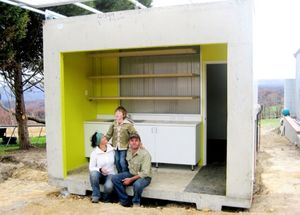
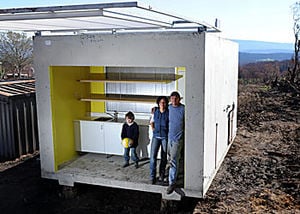
The House re-Growth Pod has been designed by architect who wanted to help with the re-building process of fire destroyed homes in Victoria. The dwelling is a completely self contained concrete service pod which is s a permanent and cost effective housing unit which can assist in the rebuilding of the fire devastated town-ships of Victoria.
The robust pre-fabricated concrete structure has been designed to be built upon, but in the short term acts as a habitable starting point for the building of a new home. The units can be prefabricated, delivered and connected to services rapidly allowing families to begin the process of re-building without displacement from their communities[9][10]
Royal Commission[edit | edit source]
The Royal Commission's terms of reference were released on Monday 16 February 2009 and include inquiring into and reporting on the following matters:
- The causes and circumstances of the bushfires.
- The preparation and planning by governments, emergency services, other entities, the community and households for bushfires in Victoria, including current laws, policies, practices, resources and strategies for the prevention, identification, evaluation, management and communication of bushfire threats and risks.
- All aspects of the response to the 2009 bushfires including immediate management, response and recovery, resourcing and coordination and equipment and communication systems.
- Measures taken to prevent the disruption to the supply of essential services such as power and water
- Any other matters deemed appropriate.
Recommendations arising out the inquiry are indicated on:
- The preparation and planning for future bushfire threats and risks, particularly the prevention of loss of life.
- Land use planning and management, including urban and regional planning
- Fireproofing of housing and other buildings, including materials used in construction
- The emergency response to the fires
- Public communication and community advice systems and strategies
- Training, infrastructure, and overall resourcing needs.
Causes of death[edit | edit source]
- Radiant heat; trapped in dwelling for shelter or while defending against fire
- Radiant heat; trapped in motor vehicle while attempting to evacuate
- Motor vehicle accident while attempting to evacuate (not confirmed)
Photographs[edit | edit source]
Acheron Way, 10 April 2009[edit | edit source]
Lake Mountain, 10 April 2009[edit | edit source]
See also[edit | edit source]
- Recent news articles on the 2009 Victorian bushfires
- 2009 Victorian bushfires Royal Commission submission
- Quotes on 2009 Victorian bushfires
References[edit | edit source]
- ↑ Death toll may reach more than 40: police, The Age, February 7, 2009
- ↑ Extreme fire risks off the scale, The Australian
- ↑ 3.0 3.1 Extreme weather was the main cause of the Black Saturday bushfires, Melbourne University seminar, 21 April 2009
- ↑ Bushfires and extreme heat in south-east Australia, Professor David Karoly, Realclimate.org
- ↑ Australian bushfires pump out millions of tonnes of carbon, guardian.co.uk
- ↑ Water harvest from dams may fall 30%, The Age, February 18, 2009
- ↑ Meet Guy, who found shelter from the fires, The Age
- ↑ We need to talk about the forests, The Canberra Times, Feb 23, 2009
- ↑ House re-Growth Pod
- ↑ Small concrete boxes to house bushfire victims, Herald Sun
External links[edit | edit source]
- Wikipedia:2009 Victorian bushfires
- Bush Fire, myenvironment.net.au, scientific and evidenced based information about bushfires and the environment with links to media, science, research and opinion articles.
- Red Cross bushfile appeal (donations accepted)
- Victorian fires 2009, (We) can do better
- Australia's bushfires: the blame game, Guy Rundle, guardian.co.uk
- Lessons from the ashes, The Age
- Interactive map of Victorian bushfires, Google.com.au
- Fires royal commission to have wide terms of reference, Premier of Victoria, Australia
- Bushfires and extreme heat in south-east Australia, RealClimate, 16 February 2009












